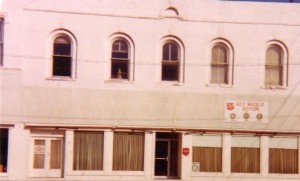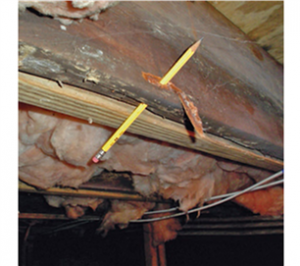
When working as an engineer in Fort Collins, our firm was hired to do some renovation work on a historic downtown building. At the time, this red brick building housed the Salvation Army ministry (pictured above). The edifice consisted of a basement and three upper levels. The nearly 100-year-old structure possessed character and distinctive architectural features.
One of the distressing features of the building was a noticeable sag in the floors in the center of the structure. If you placed a bowling ball on the floor, it would rapidly roll toward the center of the building and eventually settle there. The cause of that problem became the focus of the early part of the structural investigation.
The center of the building was supported by six massive 10” x 10” wooden columns. We discovered that in the basement these columns were partially encased in concrete in order to protect the lumber from careless equipment handlers. The concrete, designed to protect the lumber, actually aided in rotting these massive timbers. The concrete sealed the wood from fresh air and caused the wood to dry rot. These vital structural members were so rotten that we could push a pencil all the way to the center of the 10 x 10’s without difficulty. (That certainly gives one great confidence with two floors and a roof suspended overhead!) When the contractors jacked up the building to replace these aging behemoths, they needed to use two 100 ton jacks to lift the floors to the proper height.
I want you to catch this thought…
The concrete encasement designed to help protect the wooden columns actually caused the foundational elements of the building to decay. The concrete that protected the wood from splintering at the careless hands of equipment operators nearly brought the house down!
Churches today often suffer from “dry rot.” Churches that at one time were vibrant and healthy now suffer from internal decay. The culprits that cause the near-collapse of these bodies are often the very ministries that made them at one time spiritual giants. Many culprits abound. I would like to illustrate two nasty causes of church dry rot.
Form
In the U.S., churches and church popularity reached a zenith after World War II. Each denominational church group developed distinctive styles of ministry. Many churches experienced great success with their particular style. However, over time dry rot set in. The “style” became more important than the ministry. Those churches were set in concrete and began the slow, painful process of internal decay—dry rot! That which was designed to help actually became a hindrance. Children’s ministry such as Sunday School or AWANA became encased in concrete. The function followed the form rather than the reverse occurring. This is not to say that these ministries cannot be vital but neither of them are biblically mandated!

Worship style is another area ripe for dry rot. The “form” of worship can actually become a detriment to ministry.
These types ministry can be vital once again with proper adjustments. Churches that try to fit a 1950’s or 1970’s style of ministry into the 2010’s will suffer continual internal decay. We do not abandon the Word of God nor the Gospel. Those never change. However, we must constantly update our delivery systems to effectively reach our world today. Flannel graphs, overhead projectors and film strips are passé!
Mission
In church groups focused on missions, another form of dry rot develops. In these churches, the ministry centered on missions. However, many congregations became so intent on reaching those “beyond” they forgot that God had called them to their primarily mission field right in their own backyard. As a consequence we are seeing many “missionary” churches in rapid decline as their congregations grow older, and the numbers of those who can financially support the ministry decline. These churches are in danger of not only losing the support base for missions but in losing the very church itself! Dry rot!
A Solution to the Dilemma
In order for churches to begin to make an impact for the Gospel once again we must RETOOL. We need to begin to think again like a church on a mission, not like a church that has arrived! The following three shifts in thinking and in ministry are a place to begin.
Mission: First, each church must recapture its fundamental reasons for its existence: accomplishing the Great Commission with a Great Commandment passion. Does this mean we ignore “missions.” Absolutely not! But it does mean that we recognize that we are a mission outpost with a missions ministry of our own!
Become Missionaries: A closely associated second step requires that we become missionaries once again. Pastor Les Magee moved to Washington Heights in Ogden, Utah from a foreign mission field. One of the first things the church did was show the movie The God Makers. They advertised around town and invited the community. The Mormons stayed away in droves. After the showing Les thought, “If I were ministering in another country, the last thing I would do would be to show a film that bashes the local faith. I need to put on my missionary hat and begin thinking like a missionary.” That’s exactly what Les did. Washington Heights has grown tremendously ever since! They determined to “build bridges, not walls” to their local community. This became the mission, vision, and work of the entire congregation!
Understand our Culture: Third, we must understand our culture and the language of our culture once again so that we might make an impact in our neighborhoods. When we send missionaries abroad, we ask them to learn the language and learn the culture, and then we ask them to minister to the indigenous people groups. In America when we in our churches speak our “70’s culture language” and use our “70’s culture methods,” it’s like we are speaking a foreign language to those around us. We have to learn to speak the language of the culture if we want to make an impact for Jesus Christ!
What am I saying? I’m echoing the words of 1 Corinthians 9:19-22:
For though I am free from all men, I have made myself a servant to all, that I might win the more; and to the Jews I became as a Jew, that I might win Jews; to those who are under the law, as under the law, that I might win those who are under the law; to those who are without law, as without law (not being without law toward God, but under law toward Christ), that I might win those who are without law; to the weak I became as weak, that I might win the weak. I have become all things to all men, that I might by all means save some.
It’s harvest time! Let’s be about the master’s business.
Retool for Christ Jesus!



